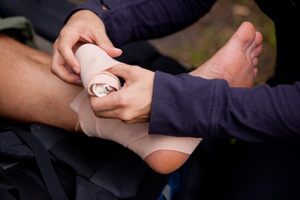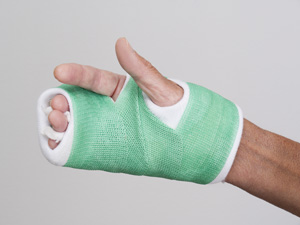Unlike adults, whose bones have reached full growth, kids and teens have bones that are still developing and growing. Consequently, these younger bones are susceptible to injury in areas where adults are not. Below are specific bone growth issues that affect kids and teens.
Osteochondroses
Osteochondroses refers to injury of the joints and places where tendons and ligaments attach. The primary causes of osteochondroses are overuse injury and/or genetic disposition.
Osgood-Schlatter's Disease
Osgood-Schlatter's disease is name d after the American and German surgeons
who first described the disorder. This problem often arises during growth
spurts. Tension in the patellar tendon (tendon that extends down the front
of the shin) causes small cracks in the growth plate. Kids and teens may
experience pain when running and jumping. The good news is that in most
cases, Osgood-Schlatter's disease does not require extensive treatment.
Symptoms often subside with rest, but may follow the child until their
growth plateaus. Surgery is rarely required.
d after the American and German surgeons
who first described the disorder. This problem often arises during growth
spurts. Tension in the patellar tendon (tendon that extends down the front
of the shin) causes small cracks in the growth plate. Kids and teens may
experience pain when running and jumping. The good news is that in most
cases, Osgood-Schlatter's disease does not require extensive treatment.
Symptoms often subside with rest, but may follow the child until their
growth plateaus. Surgery is rarely required.
Sever's Disease (Calcaneal Apophysitis)
More common in boys 7 to 8 years old, Sever's Disease occurs when the achilles tendon attaches itself to the lower part of the growth plate, making muscles tight and activity painful. Rest, stretching exercises and a heel lift or other orthotics methods may help prevent symptoms from returning.
Frieberg's Disease
More common in adolescent girls, this type of osteochondrosis affects the end of the bone around a joint, usually flattening the head of the bone during adolescence. Symptoms may include pain, swelling and restricted movement in the affected joint. There is no specific course of treatment, but special shoes, casting or surgery may be used.
Growth-Plate Injury
 Another type of growth-related injury, growth-plate fractures, occurs
in areas unique to children that determine the development of a bone.
Growth plates are softer than solid bone, but may fracture along with
a bone. If injury is sustained to growth plates, it is very important
to seek an orthopedic specialist. Some growth plate injuries may require
surgery to ensure normal bone development. More
about growth plates and growth plate injury.
Another type of growth-related injury, growth-plate fractures, occurs
in areas unique to children that determine the development of a bone.
Growth plates are softer than solid bone, but may fracture along with
a bone. If injury is sustained to growth plates, it is very important
to seek an orthopedic specialist. Some growth plate injuries may require
surgery to ensure normal bone development. More
about growth plates and growth plate injury.
Adolescent Scoliosis
Idiopathic scoliosis is a disorder of the spine, affecting girls over 10 years of age most frequently. The spine curves into a "C" or "S" position, causing asymmetry of the torso, shoulders and/or hips. According to Dr. Shaughnessy of the Mayo Clinic, there are 10 to 15 different types of scoliosis, 80% of which are idiopathic. Because scoliosis is painless during progression, it is difficult to detect during its early stages. More about scoliosis
